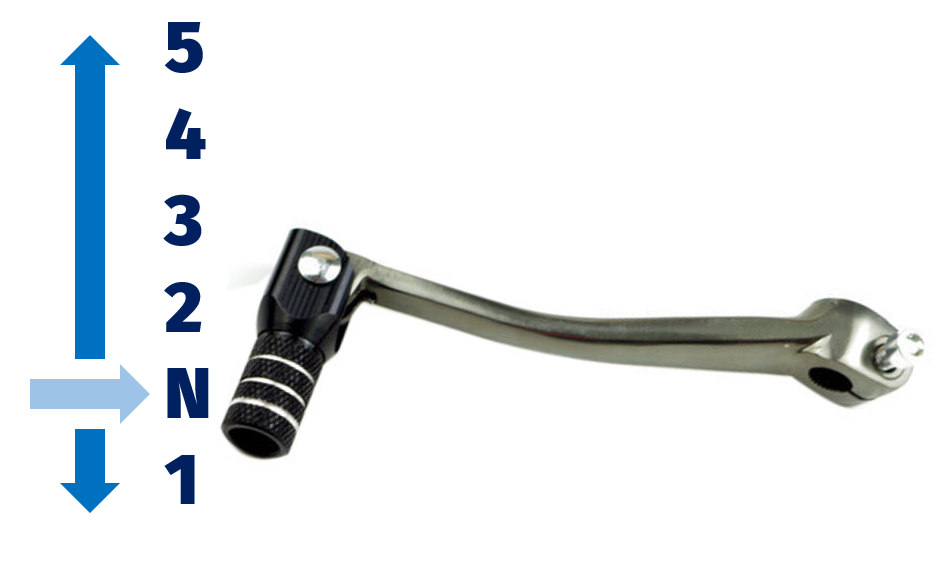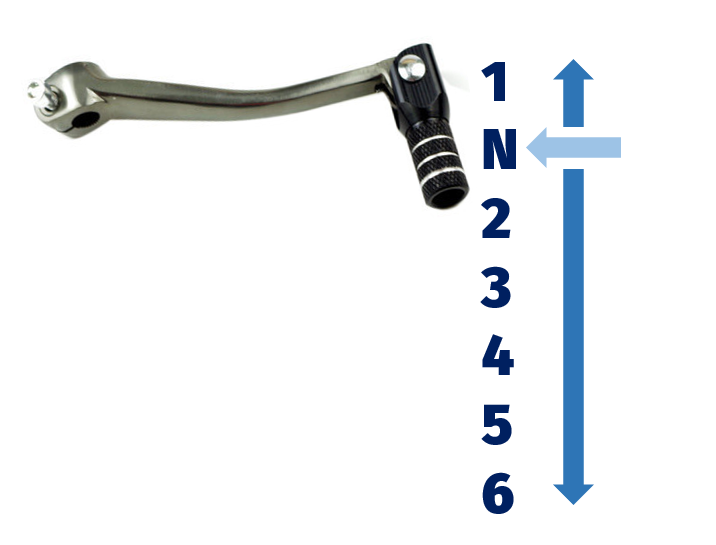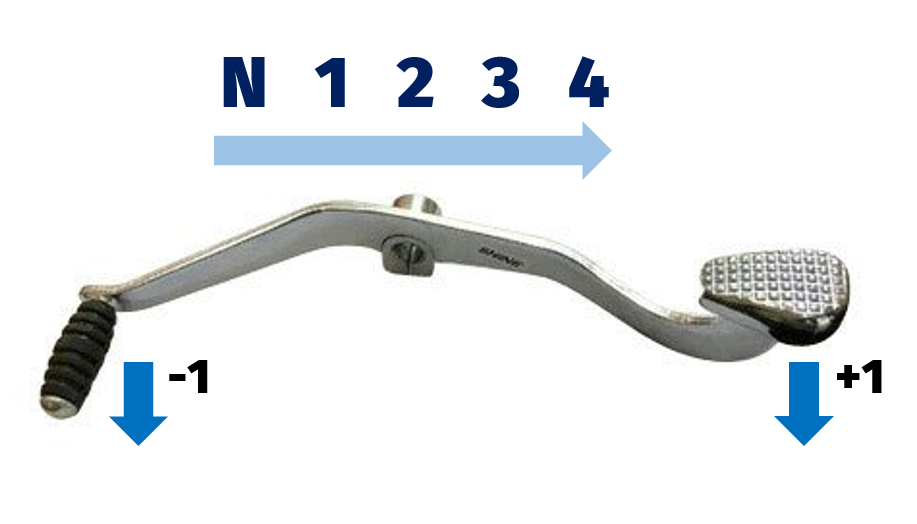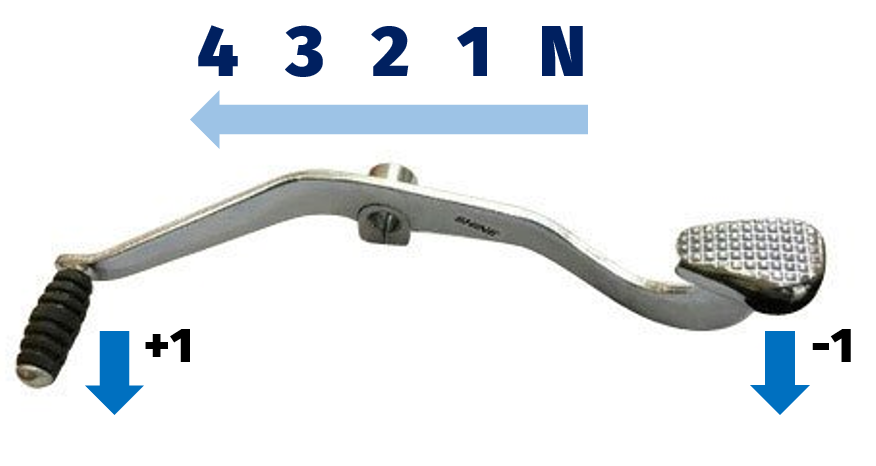Ever come across different motorcycles with completely different gear shifting patterns?
When I bought my first motorcycle, the gear shifting pattern was entirely different to the one I was used to. I had learned motorcycle riding with my dad’s bike. And it had a completely different gear shift pattern.
Imagine my difficulty in getting used to a different shifting pattern in my new motorcycle. Damn annoying!
The current motorcycle manufacturers are moving towards an universal gear shift pattern with the first gear down and the rest all gears up. However, it is going to take a long time and there are other systems out there – currently in use – for different motorcycle models.
So, what are these different motorcycle gear shift patterns present out there then? There are 5 different types of gear shift patterns that can be seen in the motorcycles.
- First Gear Down, Rest All Gears Up
- First Gear Up, Rest All Gears Down
- All Gears Up on Rear End of Lever
- All Gears Up on Front End of Lever
- All Gears Up on Rear End of Lever – except for First Gear on Front End
Confusing enough? Let us deep dive into each of these shifting patterns in detail.
#1 First Gear Down, Rest All Gears Up
This is the most universal and popular gear shift pattern right now. Most manufacturers are shifting towards this gear shift system slowly.
The gear shifting lever consists only the front end of earlier versions of gear levers. That is, there is no rear lever end available in this gear system.
For the gear change, the first gear is below the neutral gear and the rest are all up.
So, when you are at the neutral gear, you need to push the gear lever down to shift to the first gear. From there, you need to shift the lever up to change to the 2nd. The rest of the gears are reached by shifting up the lever further.

The typical gear changing journey goes like this. Starting from the neutral gear you go down to the 1st. Then you shift the lever up – to reach the 2nd gear. You shift up again for 3rd and continue to shift up further for 4th and 5th gears.
This type of gear shifting pattern is found in most of the motorcycles available out there in the market.
Also, manufacturers are moving towards this gear shift pattern more and more in the recent years. Down the decade, it won’t be surprising if this gear shifting pattern becomes universal and is the only system found in motorcycles.
#2 First Gear Up, Rest All Gears Down
This is the exact opposite of the previous system.
This type of gear shift pattern is only used in Racing Bikes. While the previous one is generally called as Road-Shift pattern, this gear shift system is called – Race-Shift pattern.
The gear lever pattern is reversed by changing how the gear lever connects to the shift spindle. This is done by simply flipping the shift spindle by 180 degrees, which turns the same motion of gear shift in the exact opposite direction.
For the gear change, the first gear is above the neutral gear and the rest are all down. The exact opposite of the above pattern.
When you are at the neutral gear, you need to push the gear lever up to shift to the first gear. From there, you need to shift the lever down to change to the 2nd. The rest of the gears are reached by shifting down the lever further.

The typical gear changing journey goes like this. Starting from the neutral gear you go up to the 1st. Then you shift the lever down to reach the 2nd gear. You shift down the lever again for 3rd and continue to press down further for 4th, 5th and 6th gears.
This gear shift pattern can only be found in the racing bikes. Hence, the gear shift pattern is popularly dubbed as Racing-Shift pattern. This pattern helps the rider to turn and race easily by shifting down to higher gears.
#3 All Gears Up on Rear End of Lever
This is another popular gear shifting pattern available in many motorcycles right now.
Although its popularity is on continuous decline, there are still many motorcycle manufacturers out there with this system.
The gear lever consists of both the front and rear ends. These 2 ends in the lever are built to differentiate the gear up and gear down shift whenever the rider presses down on these ends.
So, in this system, the rider has to press down the rear end to level up one gear and conversely, has to press down the front end to level down one gear. All the gears are up on the rear end of the lever and to gear down you should press the front end.

The typical gear changing journey starting from the neutral gear will be like this. You push the rear end down to go from the first gear to the 2nd. Then again push down the rear end of the lever to further go to 3rd and 4th gears.
To level down the gear, you need to press down the front end of the lever. Suppose, you are in the 3rd gear and want to go to neutral, you need push down the front end 3 times. From 3rd to 2nd to 1st to Neutral.
While the popularity is declining for this type of gear pattern over the years, there are still a considerable number of motorcycle models that use this system. Most Indian motorcycles have this type of gear shift pattern.
#4 All Gears Up on Front End of Lever
This gear shifting is the entire opposite of the above gear shift pattern we discussed.
While this pattern is not used extensively, there are still some motorcycle manufacturers that provide this pattern in their bikes.
Again, the gear lever consists of both the front and rear ends. However, the functionality is switched between the front and rear ends when compared to the above system.
In this system, the rider has to press down the front end to level up one gear and of course, has to press down on the rear end to level down one gear. All the gears are up on the front end of the lever and to gear down you need to push down the rear end.

The typical gear changing journey starting from the neutral gear will be like this. The rider pushes the front end of the lever down to go from the first gear to the 2nd gear. Then the rider has to again push down the front end of the lever to go further to higher gears.
To shift down the gear, the rider has to press down the rear end of the lever. If he is in the 2nd gear and wants to park at neutral, he has to push down the rear end 2 times going from 2nd gear to 1st to finally land on neutral.
This gear shift pattern is not at all common and are decreasing in their numbers and popularity day by day. However, there are still some Japanese manufacturers that use this gear changing system in their motorcycles.
#5 All Gears Up on Rear End of Lever – except for First Gear on Front End
This is a subset of the 3rd gear shift system we discussed above. Or rather, a mix of the 1st and 3rd system above.
Many argue that the all gears up on rear end of the lever system which was popular in the yesteryear evolved to the first gear down, rest all gears up system, which is the popular one now by going through this system of – All Gears Up on Rear End of Lever – except for First Gear on Front End.
In this system, the rider has to press down the rear end of the gear lever to level up and push down the front end to level down the gear – except for the 1st gear for which the rider has to push down the front end.

So, the typical journey from the neutral gear would be like this. You need to push down the front end to go from neutral to first gear. However, the rest gears are all up and you need to press down the rear end of the lever. So, from the 1st gear to go to 2nd gear, you have to push down the rear end. The same applies for higher gears as well.
Now, to go down from a higher gear to neutral, you need to push the front end of the lever down till you reach the 1st gear. And then, you press the rear end to go from 1st to neutral gear. Exactly opposite of how you went from neutral to first.
While this is a complicated shifting pattern, there aren’t a lot many motorcycles that use this shifting system currently. But don’t be surprised when you come across this shift pattern in a vintage motorcycle.
So, these are the different gear shift patterns that one can see in the current crop of motorcycles. What’s your favorite one? And what change do you foresee in the gear shifting world? Comment below.
